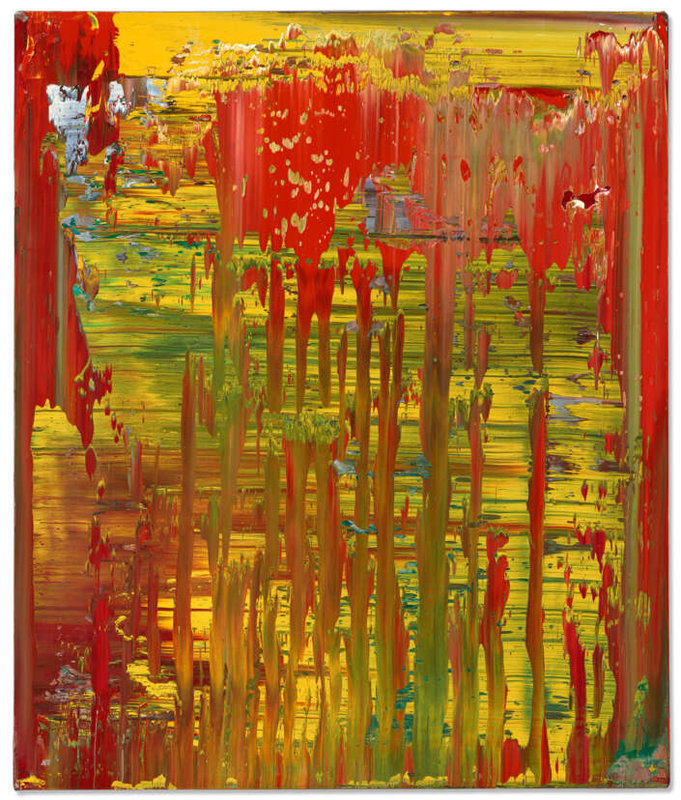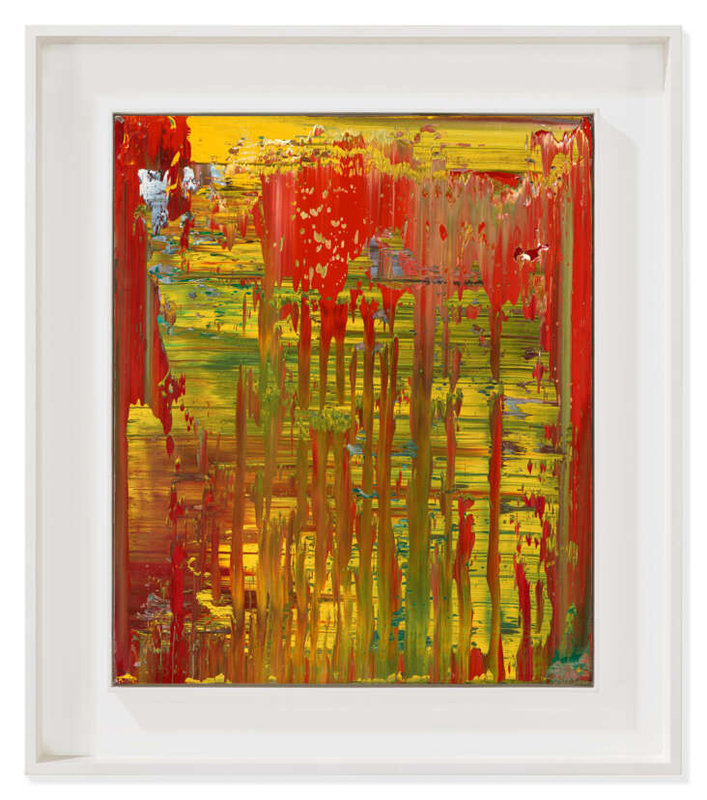Gerhard Richter (B. 1932), Abstraktes Bild (890-2)
Lot 25A. Gerhard Richter (B. 1932), Abstraktes Bild (890-2), signed, inscribed and dated twice '890-2 R. 2004 Richter 2004' (on the reverse), oil on canvas, 63 x 52.5 cm. Painted in 2004. Price realised USD 2,591,000 (Estimate USD 2,000,000 – USD 3,000,000). © Christie's 2023
Provenance: Wako Works of Art, Tokyo
Private collection, New York
Private collection, New York
Acquired from the above by the present owner.
Exhibited: Tokyo, Wako Works of Art, New Works: Gerhard Richter, November-December 2005 n.p. (illustrated).
Note: I want to end up with a picture that I haven’t planned. This method of arbitrary choice, chance, inspiration and destruction may produce a specific type of picture, but it never produces a predetermined picture. Each picture has to evolve out of a painterly or visual logic: it has to emerge as if inevitably.(G. Richter, quoted in D. Elger, Gerhard Richter: A Life in Painting, Chicago 2009, p. 312).
Gerhard Richter’s Abstraktes Bild (890-2) is a vigorous example of his critically acclaimed abstract canvases that throw aside traditional values in favor of a heady combination of chance and control. Known early on for his work with photographic sources, the artist has always been interested in giving up some of his autonomy in an effort to let the work essentially plan and build itself. “I want to end up with a picture that I haven’t planned,” Richter has noted about his abstract process. “This method of arbitrary choice, chance, inspiration and destruction may produce a specific type of picture, but it never produces a predetermined picture. Each picture has to evolve out of a painterly or visual logic: it has to emerge as if inevitably” (G. Richter, quoted in D. Elger, Gerhard Richter: A Life in Painting, Chicago 2009, p. 312). His abstract paintings are the most clear example of Richter’s embracing these chance moments, the unexpected results while still retaining a programmatic sense of control over the entire proceedings. Though tangentially linked to the emphatic work of the Abstract Expressionists, pieces like the present example highlights Richter’s investigative technique over emotion and angst.
Joseph Mallord William Turner, Sunset, circa 1830-1835. Tate, London. Photo: Tate, London / Art Resource, New York.
One of his more intimate abstracts, Abstraktes Bild (890-2) is nonetheless rife with energy and painterly motion. Even at this smaller scale, the same depth and optical richness continue to play out upon the surface of the work. Constructed from a preponderance of yellow and red, the image highlights a variety of strokes that compete for the viewer’s attention. Horizontal bands of cheery yellow hover over darker areas, the underpainting bleeding into view like a shadow beneath. On the edges, rich red makes itself known in heavy layers that echo the central streaks of paint running vertically across the whole composition. It is these stripes that exhibit the telltale texture of Richter’s squeegee process. The result is a smoothly marbled surface where a variety of colors intermingle in a swirling dance. These mixtures force the eye to find other shades within the work, and by doing so one is allowed to enter the painting and begin to investigate the built environment which Richter has constructed. “[A] picture emerges that may look quite good for a while, so airy and colourful and new,” he notes. “But that will only last for a day at most, at which point it starts to look cheap and fake. And then the real work begins—changing, eradicating, starting again, and so on, until it's done” (G. Richter, Panorama: A Retrospective, London, 2011, p. 17). Evidence of this meticulous work is brought to the surface by the artist’s machinations for a brief moment only to be plunged back into the depths with a decisive movement of his tools.
Part of his momentous series of squeegee paintings, Abstraktes Bild (890-2) and its brethren are a testament to Richter’s continued investigation of the painting process. Beginning with the photo-based works, the artist has worked in distinct groupings throughout his career. Rather than merely a fleeting blip within a larger thread, series like the Abstraktes Bilder exist in longer conversations that Richter has used to continuously challenge himself and his viewers. The current example shows a mixture of freedom and control that collide within the composition and hint at the artist’s meticulous work in the past and his journey toward a less controlled practice. When he first began making the abstract paintings, he noted that they “allowed me to do what I had never let myself do: put something down at random. And then, of course, I realized that it never can be random. It was all a way of opening a door for me. If I don't know what's coming—that is, if I have no hard-and-fast image, as I have with a photographic original—then arbitrary choice and chance play an important part” (G. Richter, quoted in Gerhard Richter: Text, London, 2009, p. 256). The squeegee paintings are created within a carefully tested system where the artist’s process rarely differs but the results can be wildly different. By choosing particular color combinations to highlight throughout the works and then smearing and dragging them around the canvas, Richter is able to form complex relationships that are not predetermined or rooted within visual tradition.
Throughout his career, Richter has been doggedly curious about the art of painting and its boundaries. As a young artist in the mid-1950s, he studied in Dresden, but a visit to Documenta II in 1959 sparked his creative fire and precipitated his move to West Germany in 1961. There he began his work in earnest at the Kunstakademie in Düsseldorf. Speaking about his experience at Documenta, the artist remarked: “At the exhibition, I was looking for realistic paintings, and hardly found anything I liked, and then I saw Pollock and Fontana – and I was shocked. They were so brazen. One had just made a cut in the canvas, the other had dripped paint on it. I was completely unprepared for that…It had an influence, in the sense that it was one more reason to leave the GDR” (G. Richter, quoted in “I Have Nothing to Say and I’m Saying It: Conversation Between Gerhard Richter and Nicholas Serota, Spring 2011” in M. Godfrey and N. Serota, Gerhard Richter: Panorama, exh. cat., Tate Modern, London, 2011, p. 20). Fontana’s Tagli interrupted the hallowed surface of the painting, causing the young Richter to reevaluate his own relationship with the history of the artform. Though his results were much different than the Argentine artist’s, both rebelled against the rarified space of the work, choosing instead to situate it firmly within a physical reality which the audience also inhabits. By connecting with the physical world in this way, and by emphasizing process and production, works like Abstraktes Bild (890-2) push the limits of what painting has been and will be.
[The abstract squeegee paintings] allowed me to do what I had never let myself do: put something down at random. And then, of course, I realized that it never can be random. It was all a way of opening a door for me. If I don't know what's coming—that is, if I have no hard-and-fast image, as I have with a photographic original—then arbitrary choice and chance play an important part. (G. Richter, quoted in Gerhard Richter: Text, London, 2009, p. 256).
Christie's. 21st Century Evening Sale, 7 November 2023

/https%3A%2F%2Fprofilepics.canalblog.com%2Fprofilepics%2F1%2F0%2F100183.jpg)
/https%3A%2F%2Fstorage.canalblog.com%2F03%2F02%2F119589%2F96711876_o.jpg)
/https%3A%2F%2Fstorage.canalblog.com%2F11%2F31%2F119589%2F94773502_o.jpg)
/https%3A%2F%2Fstorage.canalblog.com%2F20%2F83%2F119589%2F94772815_o.jpg)
/https%3A%2F%2Fstorage.canalblog.com%2F26%2F72%2F119589%2F75604929_o.jpg)
/https%3A%2F%2Fstorage.canalblog.com%2F59%2F60%2F119589%2F26458628_o.jpg)




/http%3A%2F%2Fstorage.canalblog.com%2F85%2F41%2F119589%2F129336877_o.jpg)
/http%3A%2F%2Fstorage.canalblog.com%2F49%2F31%2F119589%2F129152682_o.jpg)
/http%3A%2F%2Fstorage.canalblog.com%2F55%2F54%2F119589%2F128978735_o.jpg)
/http%3A%2F%2Fstorage.canalblog.com%2F25%2F57%2F119589%2F128085437_o.jpg)